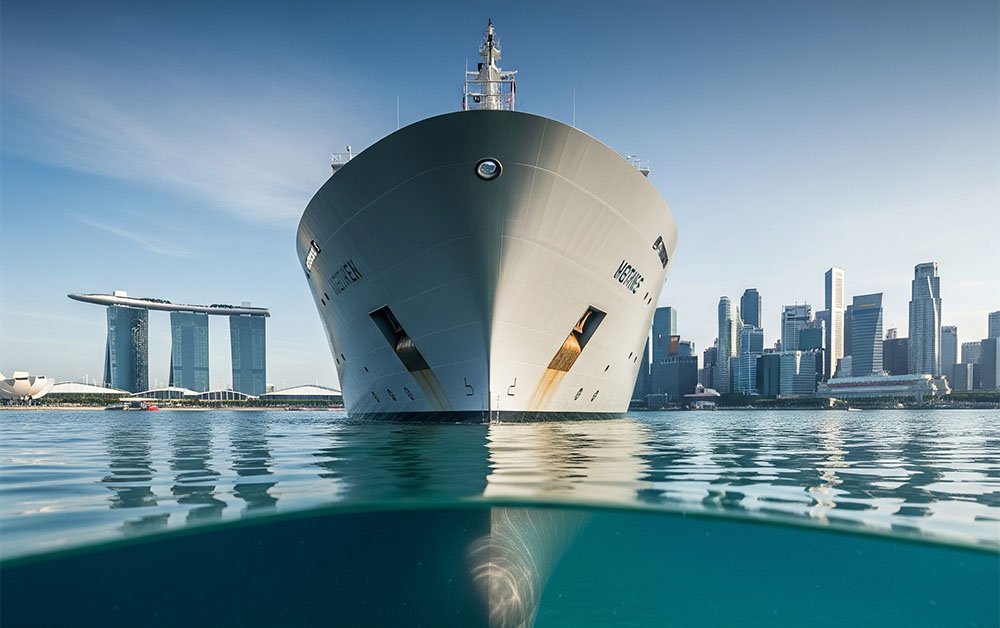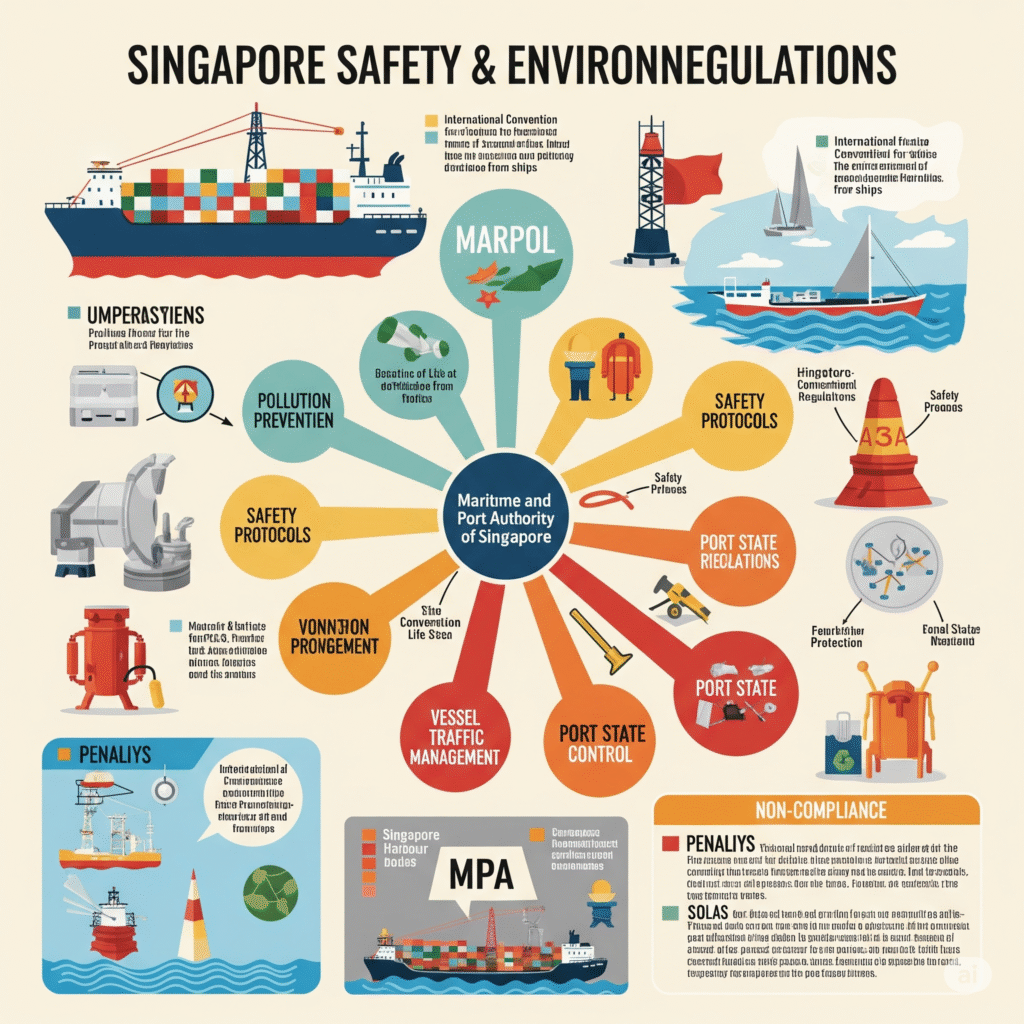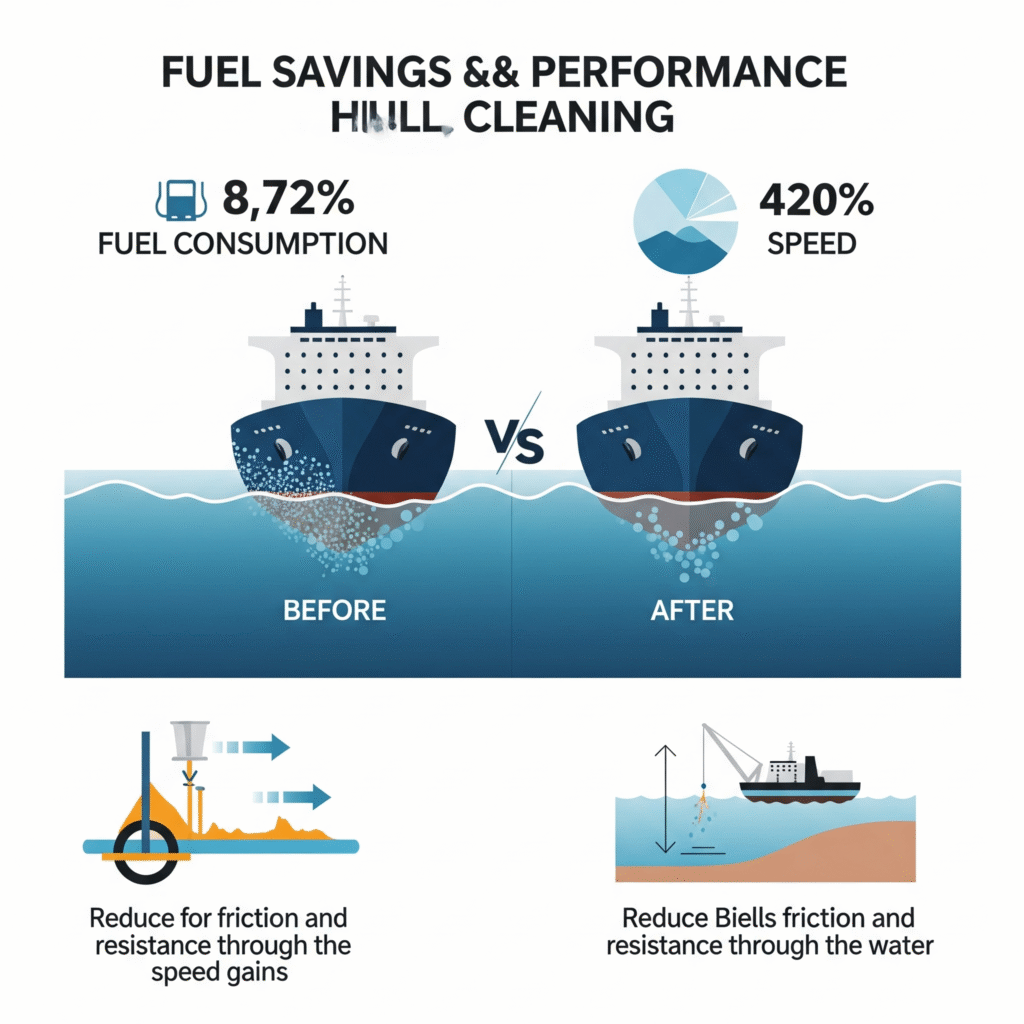Underwater Hull Cleaning in Singapore – Maximizing Vessel Efficiency and Promoting Maritime Sustainability
Singapore stands as one of the world’s busiest and most strategic maritime hubs, with thousands of vessels passing through its waters daily. This bustling port plays a crucial role in global shipping and trade, emphasizing the importance of proper vessel maintenance. One often overlooked yet vital aspect of vessel upkeep is underwater hull cleaning. This maintenance task significantly boosts fuel efficiency, extends the operational lifespan of vessels, and ensures strict compliance with environmental regulations.

In this comprehensive guide, we explore the fundamentals of underwater hull cleaning, its importance in Singapore’s unique marine environment, the most effective cleaning methods, the costs involved, and legal considerations. We also cover preventive measures that vessel owners can adopt to keep their hulls clean longer.
Understanding Underwater Hull Cleaning in Singapore
Underwater hull cleaning is the process of removing marine growth—commonly known as biofouling—from the submerged sections of a vessel’s hull. Biofouling includes organisms like barnacles, algae, slime, seaweed, and mollusks. Over time, these organisms create a rough layer that disrupts the smooth flow of water along the hull. This disruption leads to increased hydrodynamic drag, which reduces vessel speed and significantly raises fuel consumption.
Typically, hull cleaning is performed without dry-docking, which is a costly and time-consuming process where vessels are taken out of the water for maintenance. Instead, underwater hull cleaning is done while the vessel remains afloat. This allows for quick turnaround times and minimal operational downtime, which is especially valuable in a high-traffic port like Singapore.
Why Underwater Hull Cleaning in Singapore Is Vital
Singapore’s tropical waters create an ideal environment for marine life to thrive, causing vessels to accumulate biofouling at a much faster rate than in colder regions. The significance of hull cleaning in Singapore cannot be overstated, as neglecting this maintenance task can lead to serious operational, financial, and environmental consequences.
Enhanced Fuel Efficiency and Reduced Emissions
Even a thin layer of biofouling can reduce a vessel’s speed by up to 10%. Consequently, vessels consume up to 30% more fuel to maintain their cruising speed. This increased fuel burn raises operational costs and contributes substantially to greenhouse gas emissions. Given Singapore’s strong commitment to sustainable maritime practices, regular hull cleaning directly supports environmental goals by lowering fuel consumption and carbon emissions.
Improved Vessel Performance and Engine Longevity
A fouled hull creates additional water resistance, forcing engines to work harder. This overexertion accelerates engine wear and increases the frequency and cost of repairs. Clean hulls reduce drag, allowing engines to operate efficiently, prolonging their lifespan, and enhancing the vessel’s overall performance.
Prevention of Hull Corrosion and Structural Damage
Marine organisms can bore into the hull’s protective coatings. Once these coatings are compromised, saltwater accelerates corrosion on the metal hull beneath. Over time, this weakens the vessel’s structural integrity, potentially leading to expensive repairs or even endangering vessel safety.

Compliance with Environmental and Biosecurity Laws
Singapore enforces strict biosecurity laws to prevent the spread of invasive marine species. Biofouling can transport these harmful species across regions, threatening local ecosystems. The Maritime and Port Authority of Singapore (MPA) mandates that vessels maintain clean hulls to mitigate ecological risks. Failure to comply can result in fines, vessel detention, or loss of operating licenses.
Common Methods Used in Underwater Hull Cleaning in Singapore
The maritime industry in Singapore utilizes a range of innovative and environmentally responsible hull cleaning methods. These methods ensure vessels remain in optimal condition while minimizing ecological impact.
Diver-Based Manual Underwater Hull Cleaning in Singapore
Highly trained divers perform manual cleaning using tools such as brushes, scrapers, and rotary machines. This method is highly effective for small to medium-sized vessels and allows for precision cleaning, especially in sensitive or hard-to-reach areas.
Robotic and Remotely Operated Vehicle (ROV) Cleaning
Robotic systems equipped with rotating brushes, suction devices, and high-definition cameras are increasingly popular for cleaning large vessels. These robots operate underwater with precision and speed, removing fouling evenly across the hull. They also eliminate human risk and reduce labor costs.
Ultra-High Pressure Water Jetting
This technique employs pressurized water jets to dislodge biofouling without damaging antifouling coatings. The method is eco-friendly, avoids chemical contamination, and is highly effective at removing stubborn growth. Singapore’s maritime regulations favor such green technologies.
Eco-Friendly Brush Cart Systems
These systems are magnetically attached to the hull and use soft brushes along with biodegradable cleaning agents. This approach cleans efficiently without contaminating local waters, supporting Singapore’s commitment to marine conservation.
Recommended Frequency for Hull Cleaning
The frequency of underwater hull cleaning depends on multiple factors, including:
- The vessel’s purpose (cargo, commercial, leisure)
- Time spent operating in warm, nutrient-rich waters
- The type and condition of the antifouling coating applied
- Regulatory inspection schedules and compliance requirements
In Singapore’s tropical environment, cleaning every 3 to 6 months is advisable. Vessels operating continuously or in highly fouling-prone waters may require even more frequent cleaning to maintain performance and compliance.
Cost Factors and Pricing for Underwater Hull Cleaning in Singapore

Several variables influence the cost of hull cleaning:
| Factor | Description |
| Vessel Size | Larger vessels require more time and resources |
| Level of Fouling | Heavily fouled hulls may need multiple cleaning sessions |
| Accessibility | Difficult-to-reach areas and tight berths add complexity |
| Cleaning Method | Manual, robotic, water jetting, or eco-friendly options |
Estimated Price Ranges
- Small boats and yachts: SGD 300–800
- Mid-sized commercial vessels: SGD 1,000–2,500
- Large cargo and container ships: SGD 3,000–7,000
Though initial costs may seem significant, the benefits outweigh the expenses. Savings from improved fuel efficiency and reduced repair costs quickly provide a high return on investment.
Choosing a Professional Hull Cleaning Service in Singapore
Selecting the right cleaning provider is crucial. Here are the key factors to consider:
MPA Certification and Compliance
Ensure the company holds certifications from the Maritime and Port Authority of Singapore. Certified operators follow strict guidelines and legal requirements, ensuring safe and lawful hull cleaning.
Experience and Technological Capability
Choose providers with extensive experience servicing different vessel types. Advanced technology, such as robotic cleaners and underwater cameras, can enhance cleaning quality and safety.
Environmental Responsibility
The provider should use biodegradable cleaning agents and prevent the spread of invasive species. Eco-conscious cleaning aligns with Singapore’s environmental policies.
Comprehensive Documentation
Professional companies offer detailed pre- and post-cleaning inspection reports, photographic evidence, and fouling analysis. Such documentation supports regulatory compliance and maintenance records.
Legal and Environmental Framework Governing Hull Cleaning in Singapore

Singapore’s commitment to marine protection is reflected in rigorous laws governing hull cleaning:
- Prevention of Pollution of the Sea Act (PPSA): Prohibits discharges that harm marine environments.
- International Maritime Organization (IMO) Biofouling Guidelines: Set global standards to control biofouling risks.
- Maritime and Port Authority’s Hull Cleaning Regulations: Enforce strict cleaning protocols to prevent invasive species transfer.
Non-compliance risks hefty fines, vessel detention, and operational disruptions. Engaging certified professionals ensures adherence to these regulations.
Preventive Strategies to Minimize Biofouling
Adopting proactive measures helps extend the period between hull cleanings:
- Advanced Antifouling Coatings: Silicone and copper-based paints reduce marine growth adherence.
- Regular Inspections: Periodic underwater checks detect fouling early, preventing heavy accumulation.
- Avoid Prolonged Stays in Shallow Waters: Shallow and stagnant waters encourage rapid biofouling.
- Ultrasonic Antifouling Devices: These emit sound waves that deter marine organisms from settling.
Such strategies optimize vessel maintenance costs and operational efficiency.
Environmental Impact and Sustainability
Underwater hull cleaning is a cornerstone of sustainable maritime practices. It lowers greenhouse gas emissions by improving fuel efficiency. Also, it reduces the spread of invasive species, which can disrupt marine ecosystems. Singapore’s maritime industry actively promotes eco-friendly hull cleaning methods to protect its rich marine biodiversity.
The Future of Underwater Hull Cleaning in Singapore
Technological advancements are driving the future of hull cleaning. Innovations like AI-powered robots, real-time monitoring systems, and eco-friendly cleaning agents are becoming industry standards. Singapore’s maritime sector is at the forefront of adopting these technologies, combining efficiency with environmental stewardship.
Conclusion
Underwater hull cleaning in Singapore is more than a maintenance task—it is essential for operational efficiency, cost savings, regulatory compliance, and environmental protection. Regular cleaning enhances vessel performance, extends asset life, and supports Singapore’s commitment to sustainable shipping.
Vessel owners and operators should prioritize professional, eco-friendly hull cleaning services to maximize benefits. Choosing certified providers ensures safe, compliant, and high-quality cleaning that protects both vessels and the ocean.
Keep your vessel’s hull clean to navigate the future of maritime trade with confidence, efficiency, and responsibility.
If you’re looking for efficient and environmentally safe hull cleaning in Singapore, CleanShip provides professional services tailored to modern maritime needs.
FAQs
1. What is underwater hull cleaning in Singapore, and why is it necessary?
Underwater hull cleaning is the process of removing marine growth like algae, barnacles, and slime from a ship’s hull while it remains in the water. It is essential for improving fuel efficiency, vessel speed, and preventing damage caused by biofouling.
2. How often should hull cleaning be done in Singapore?
The frequency depends on the vessel type, operating environment, and antifouling systems used. In Singapore’s warm waters, cleaning is typically recommended every 3 to 6 months to maintain optimal performance.
3. Is underwater hull cleaning allowed in Singapore?
Yes, but it must comply with the regulations set by the Maritime and Port Authority of Singapore (MPA). Only approved service providers using eco-friendly methods are permitted to perform hull cleaning in designated areas.
4. What methods are used for underwater hull cleaning in Singapore?
Common methods include diver-based cleaning using hand tools or brushes and robotic systems that use water jets, brushes, or cavitation technology. Some providers also offer non-intrusive ultrasonic cleaning options.
5. Can hull cleaning be done while the vessel is in operation?
Hull cleaning typically requires the vessel to be stationary, often performed at anchor, in port, or in special cleaning zones. Mobile hull cleaning robots, however, allow for cleaning with minimal downtime, making it more efficient for commercial operators.


